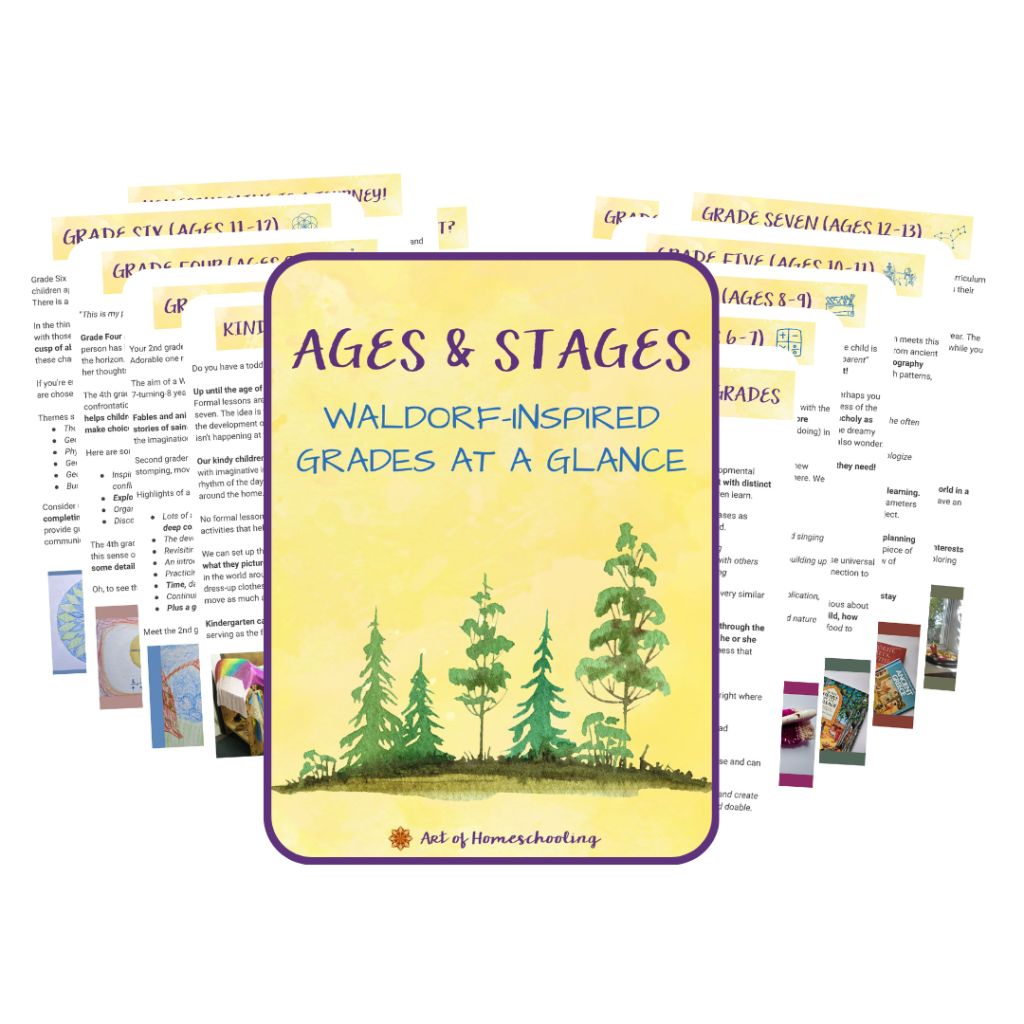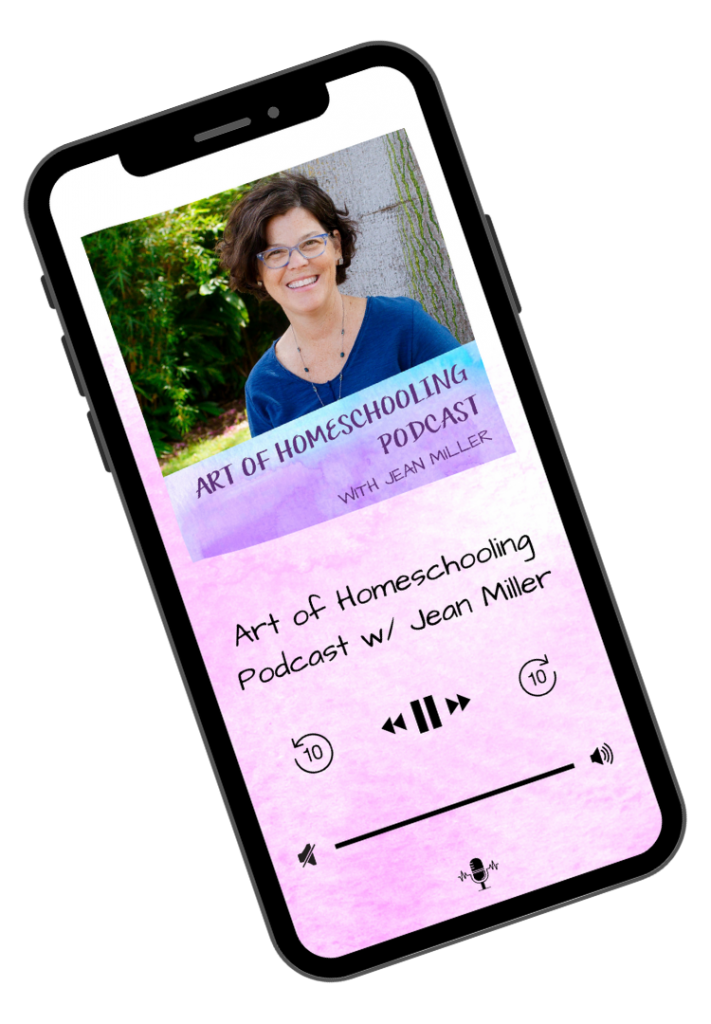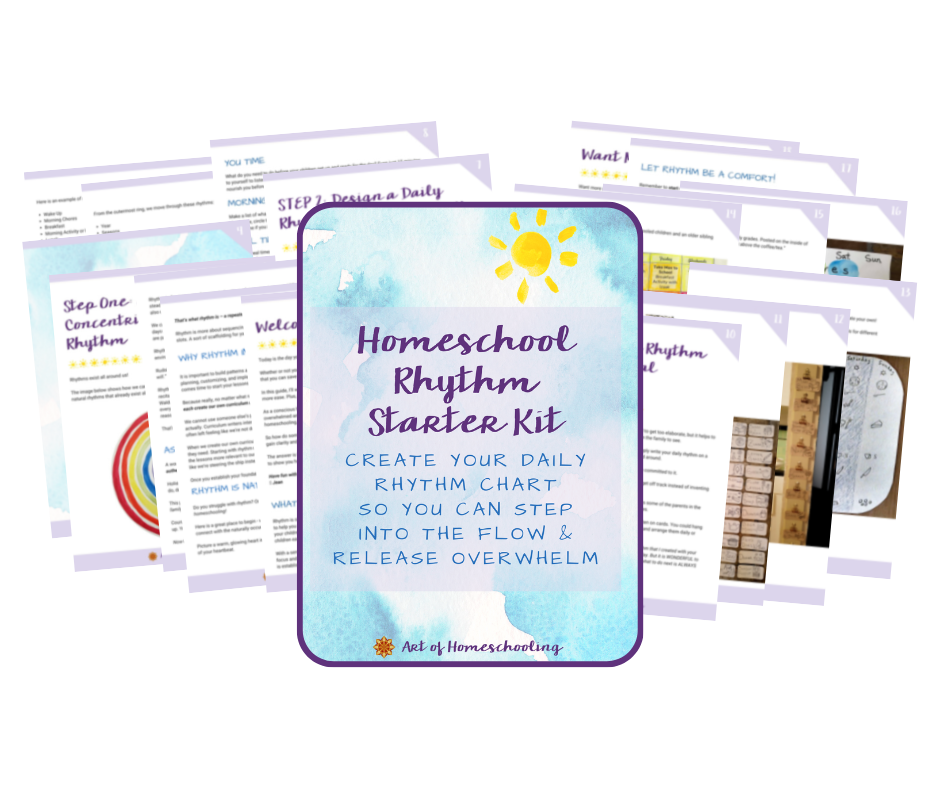Episode 197
How do homeschooling lessons shift as our children move up in the grades? In this episode of the podcast, I’m excited to share with you insights about homeschooling fourth grade.
This is part of a series where we’re diving deep into the ages and stages of each grade. We’re building a wonderful library for you to refer back to, again and again, whenever you need inspiration and guidance about Waldorf-inspired homeschooling in the grades. If you have a child in kindergarten or grades one through three, you’ll find links to those episodes below. And if you have a child in grade five or up, stay tuned as we release a new podcast in this series every month.
The Fourth Grade Basket
Fourth grade is often described as a year of “fire and ice.” The Waldorf curriculum suggestions for this year include many images of opposing forces and conflict. The child meets these forces through the Norse myths, stories of a land literally shaped by fire and ice.
The fourth grade child is ten-turning-eleven. Double digits!
It might feel like your child has said good-bye to early childhood and is firmly dwelling in that “golden hour” between the nine-year change and the onset of puberty.
For the child, there is now a strong experience of an inner and an outer world. The inner world of me and myself versus the outer world of you and others are becoming quite distinct.
The fourth grader is ready to take in the details of her surroundings. And to begin to organize his thoughts about the world.
When my oldest was this age, I remember the year being full of so many aha moments. I could just see the lightbulbs going off in his head.
So let’s dive into homeschooling fourth grade with Waldorf inspiration. And take a look at the supplies and resources you may want to explore this year.
You’ll find all the links from the episode in the show notes below.
Homeschooling Fourth Grade
To meet the child where they are developmentally, the Waldorf-inspired fourth grade curriculum provides the child with many expressions of conflict and confrontation, which meets both their curious and mischievous inclinations.
The curriculum helps children understand that as human beings, we have special gifts and so we can make choices about how we use those gifts.
Here are some highlights of the fourth grade curriculum:
- Inspiring stories from Norse mythology or ancient stories exploring themes of conflict and confrontation, mischievousness and strength
- Exploring gifts of the animal kingdom through zoology
- Organizing the world through fractions and mathematical patterns
- Discovering local geography and a sense of place
Here’s a snapshot from fourth grade at our house. During our local geography block, we took lots of field trips.
One wonderful experience was paddling on a lake in a big canoe just like the Voyageurs had used to come across Lake Erie from Canada. My son was amazed when he gazed across Lake Erie, which honestly looks more like an ocean because most days, you can’t even see the other side. His eyes got really big as he realized that early settlers had paddled canoes like the one we experienced all the way across this great lake.
Oh, to see the world through the eyes of a ten year old!
Your Changing Role as the Parent-Teacher
I also want to mention that your role as the parent-teacher is changing as well, as your child grows through the ages and stages!
As our children mature, we begin to gradually turn more and more responsibility over to them.
So I encourage you to think about how you might start to do that in really small ways in fourth grade.
Gradual is the operative word here. We’re still partnering with our children on the learning journey, but we want to begin thinking about what learning independence looks like so that we can slowly move toward that by the time they’re in high school.
You might start assigning a book for them to read independently for one of your blocks this year. Or ask them to complete some of their main lessons or practice lessons on their own. Or give them a little challenge or independent project.
Because remember, it’s their learning journey. And independence and ownership are the ultimate goals!
Supplies for Homeschooling Fourth Grade
What’s in the fourth grade basket? What supplies are wonderful to have on hand for this year of learning?
I’ve included my referral links to some items for your convenience. You can read my full disclosure policy here.
- Keep those colored pencils and other supplies from the previous grades on hand
- Chalkboards and dry-erase boards in a variety of sizes for language arts practice as writing extends from sentences to paragraphs, and for math practice as the four processes extend to work with three and four-digit numbers and beyond
- Blank books, main lesson books, or drawing paper and a folder, portfolio, or 3-ring binder for recording the learning
- Math practice books with or without grid lines for lining up multi-digit problems
- A fraction tiles board or handmade fraction manipulates
- Modeling clay, either plasticine modeling clay which doesn’t dry out and can be reused, or air-drying clay for creating longer-lasting pieces
- Tools for measuring like rulers, a balance scale, pitchers and containers for measuring volume, and a measuring wheel (which some libraries may have available to check out from their media or learning collections)
Resources for Your Fourth Grade Basket
Now for some resources to add to your fourth grade basket.
Here are some of my favorite reference books to include in your basket this year (with my referral links):
- A good map or atlas of your local area and region ~ We found really interesting maps along with stories of the first peoples at our local historical society and other history museums.
- A variety of library resources for exploring the animal kingdom ~ fiction and non-fiction, picture books, novels or short stories, and animal encyclopedias
- A math overview or dictionary to have on hand as a handy reference for you as the parent to review math skills like All the Math You’ll Ever Need or the Usborne Illustrated Math Dictionary.
- For working with math facts ~ free downloads from Jamie York Academy, the Fourth Grade Flashcards and Math Facts Review Sheets for this age.
- The Handbook of Nature Study by Anna Comstock
- A book of Norse Myths like D’Aulaire’s Book of Norse Myths
- The Tasks and Content of the Steiner-Waldorf Curriculum by Rawson, Richter, and Avison
Navigating through the Ages and Stages of Waldorf-inspired Homeschooling
Find a ✨FREE✨ printable guide to the ages and stages of Waldorf-inspired homeschooling HERE!
The Ages & Stages Guide: Waldorf-Inspired Grades at a Glance is an invaluable resource for your homeschooling reference library! It offers highlights and main lesson topics from each grade, kindergarten through grade eight.
I hope this peek into my fourth grade basket has helped you picture what homeschooling fourth grade might look like in your home.
And don’t miss other episodes in this Ages & Stages series:
- Kindergarten ~ Episode 182: The Kindergarten Basket
- First Grade ~ Episode 185: The First Grade Basket
- Second Grade ~ Episode 187: The Second Grade Basket
- Third Grade ~ Episode 192: The Third Grade Basket
- Fourth Grade ~ Episode 197: The Fourth Grade Basket
- Fifth Grade ~ Episode 201: The Fifth Grade Basket
- Sixth Grade ~ Episode 204: The Sixth Grade Basket
- Seventh Grade ~ Episode 207: The Seventh Grade Basket
- Eighth Grade ~ Episode 210: The Eighth Grade Basket
Until next time!💜

Rate & Review the Podcast
If the Art of Homeschooling Podcast has inspired you, I’d LOVE it if you could rate and review the podcast on your favorite podcast player! Reviews can be left on Apple Podcasts (iTunes), Podcast Addict, or Stitcher.
Or simply pop on over to lovethepodcast.com/artofhomeschooling and choose where you want to leave your review.
And if you want to show your appreciation for the Art of Homeschooling Podcast, you can buy me a cup of tea!
Never Miss an Episode!
Check Out All the Episodes





